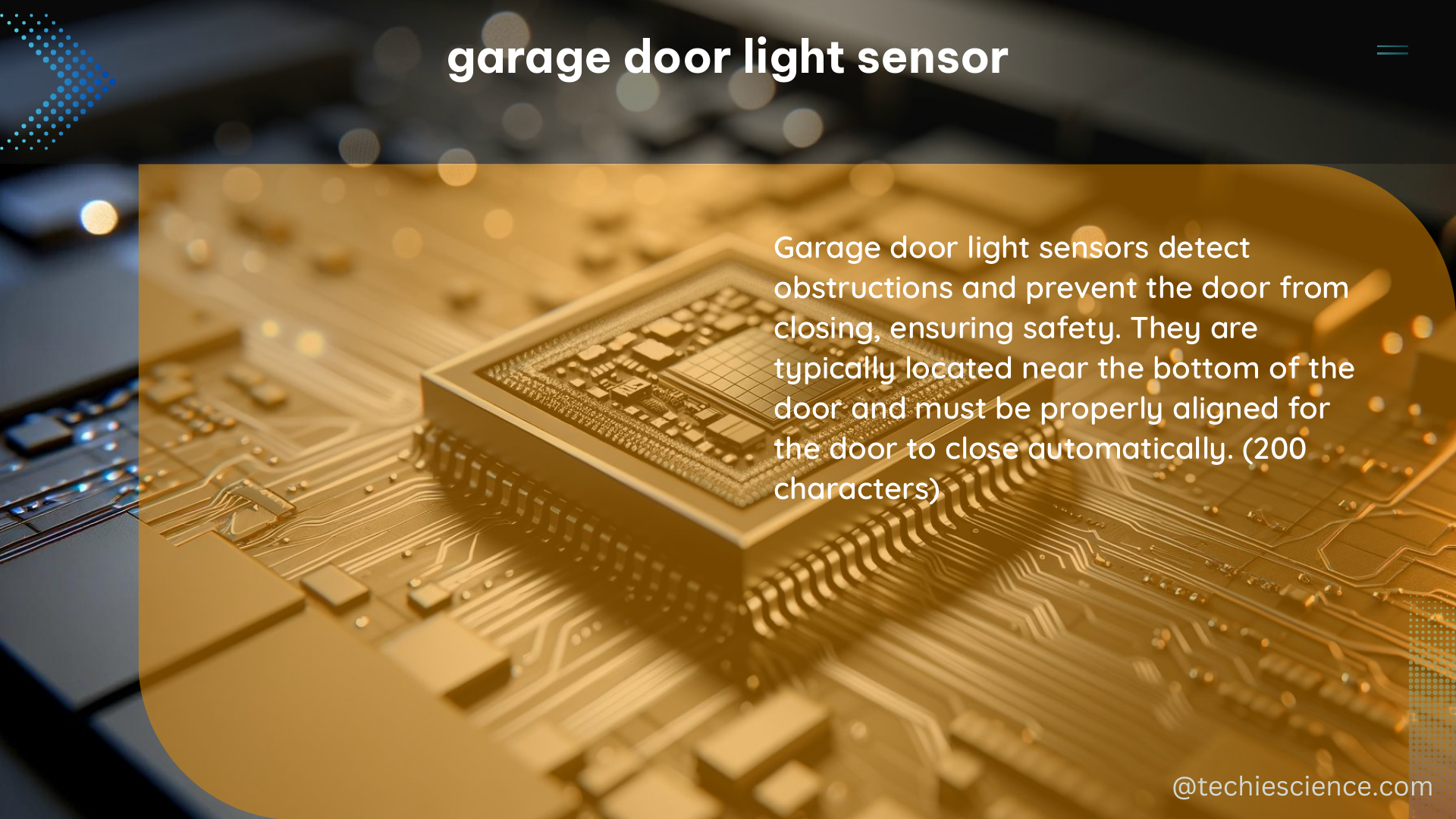The garage door light sensor is a crucial safety feature in modern garage door openers, designed to prevent accidents by detecting obstructions in the door’s path. The sensor emits an infrared beam across the door’s path, and if the beam is interrupted, the door will not close, reversing its direction instead.
Understanding the Voltage and Current Characteristics
To measure the voltage and current of the garage door light sensor, we can refer to the search results provided. According to the information gathered, the sensor terminals have about 6 volts DC across them, with the middle screw being the ground/negative and the right screw being the positive. Shorting the two terminals together results in about 60 mA of current flowing. This suggests that the sensor has a voltage drop of around 6 volts and a current draw of approximately 60 mA when the beam is unobstructed.
| Measurement | Value |
|---|---|
| Voltage Across Terminals | 6 VDC |
| Current Draw (Terminals Shorted) | 60 mA |
Furthermore, the information explains that the sensor’s output is sent back to the head unit over the same power leads by shunting the leads together to indicate that the beam is not obstructed. The absence of these pulses causes the opener to be unwilling to close the door, and it reverses to the open position automatically if the pulse train is lost while the door is closing. This implies that the sensor’s output is a series of pulses, which are used to indicate the status of the beam to the opener.
Emulating the Sensor’s Output

To emulate the sensor’s output, the information suggests using an ATTiny85, an N-type mosfet, a 7805 regulator, and a few caps & resistors to create a compact standalone unit that emulates the “all clear” signal and allows the opener to function normally. This circuit provides a regulated 5VDC power supply to the ATTiny via the 7805 regulator, and the output of the receiver is sent back to the head unit over the same power leads by shunting the leads together, just like the original sensor.
The key components and their functions in this emulation circuit are:
- ATTiny85: A small, low-power microcontroller that generates the pulse train to emulate the sensor’s output.
- N-type MOSFET: Used to switch the power leads and shunt them together, simulating the sensor’s output.
- 7805 Regulator: Provides a regulated 5VDC power supply to the ATTiny85 from the sensor’s 6VDC input.
- Capacitors: Used for power supply filtering and stabilization.
- Resistors: Provide the necessary biasing and current limiting for the MOSFET and microcontroller.
By using this emulation circuit, you can bypass the original sensor and allow the garage door opener to function normally, even if the sensor is malfunctioning or intentionally disabled.
Troubleshooting and Maintenance
When working with the garage door light sensor, it’s important to keep the following points in mind for troubleshooting and maintenance:
- Sensor Alignment: Ensure that the sensor is properly aligned and the infrared beam is unobstructed. Misalignment can cause the sensor to malfunction and prevent the door from closing.
- Sensor Cleaning: Regularly clean the sensor’s lenses and housing to remove any dust, debris, or cobwebs that may accumulate over time, as this can interfere with the sensor’s operation.
- Sensor Replacement: If the sensor is damaged or malfunctioning, it’s recommended to replace the entire sensor unit rather than attempting to repair it. Replacement sensors are readily available and can be easily installed.
- Power Supply Verification: Check the power supply to the sensor, ensuring that the 6VDC voltage is within the specified range and that the current draw is around 60mA when the beam is unobstructed.
- Emulation Circuit Validation: If using an emulation circuit, thoroughly test it to ensure that it is accurately simulating the sensor’s output and that the garage door opener is responding correctly.
By understanding the technical details of the garage door light sensor and following best practices for troubleshooting and maintenance, you can ensure the safe and reliable operation of your garage door system.
Conclusion
The garage door light sensor is a critical safety feature that plays a vital role in preventing accidents and ensuring the smooth operation of your garage door. By understanding the sensor’s voltage and current characteristics, as well as the principles behind emulating its output, you can effectively maintain, troubleshoot, and even bypass the sensor if necessary. This comprehensive guide has provided you with the technical details and practical knowledge to confidently work with the garage door light sensor and keep your garage door system functioning at its best.
References:
– Bypassing/Emulating Garage Door Opener Safety Sensors
– Garage Door Opener Safety Sensor Bypass
– Garage Door Opener Safety Sensor Emulation

The lambdageeks.com Core SME Team is a group of experienced subject matter experts from diverse scientific and technical fields including Physics, Chemistry, Technology,Electronics & Electrical Engineering, Automotive, Mechanical Engineering. Our team collaborates to create high-quality, well-researched articles on a wide range of science and technology topics for the lambdageeks.com website.
All Our Senior SME are having more than 7 Years of experience in the respective fields . They are either Working Industry Professionals or assocaited With different Universities. Refer Our Authors Page to get to know About our Core SMEs.